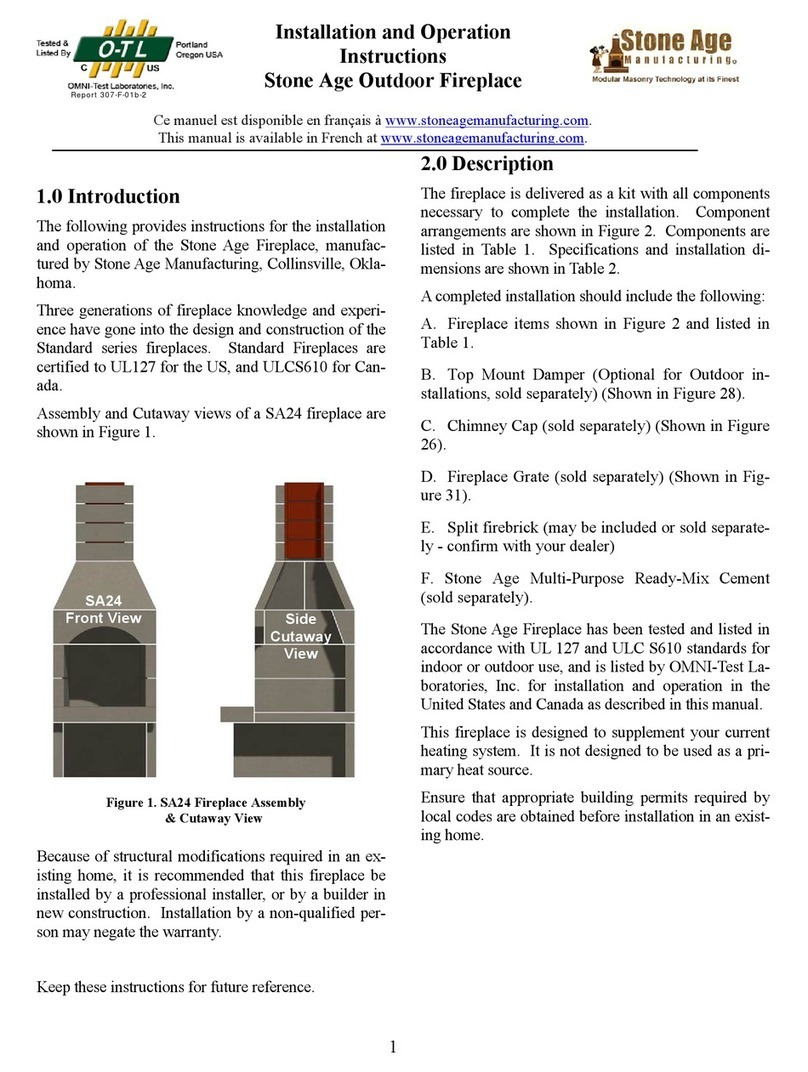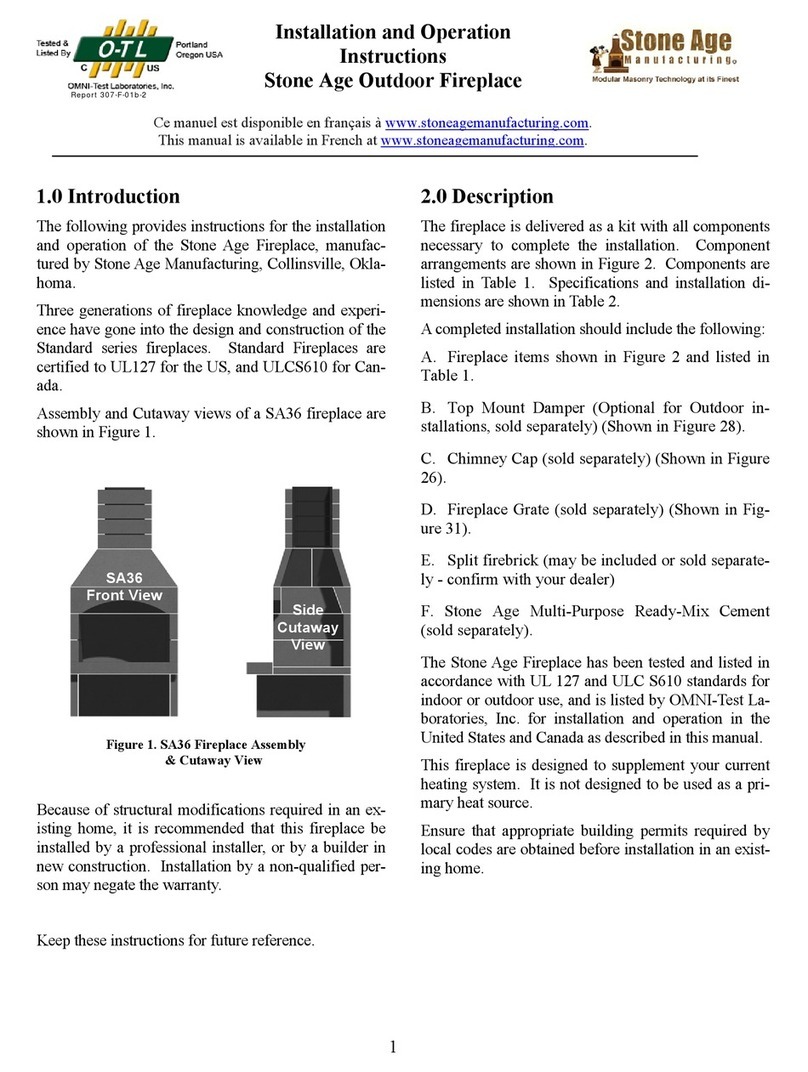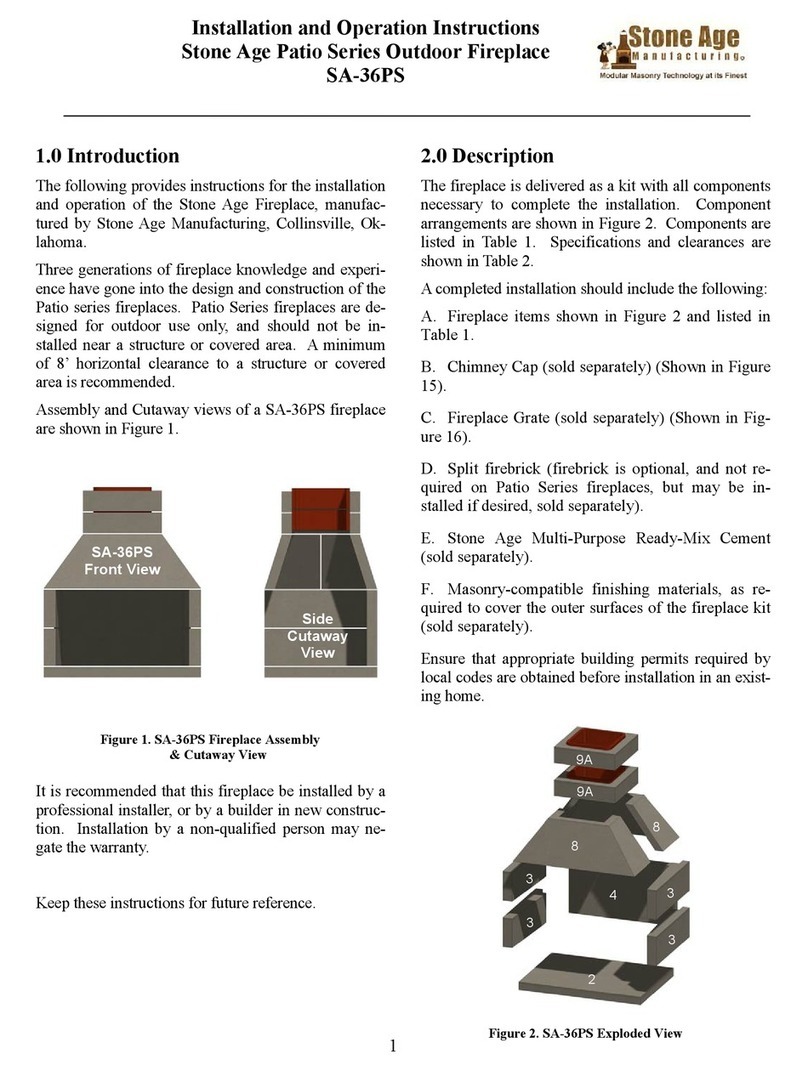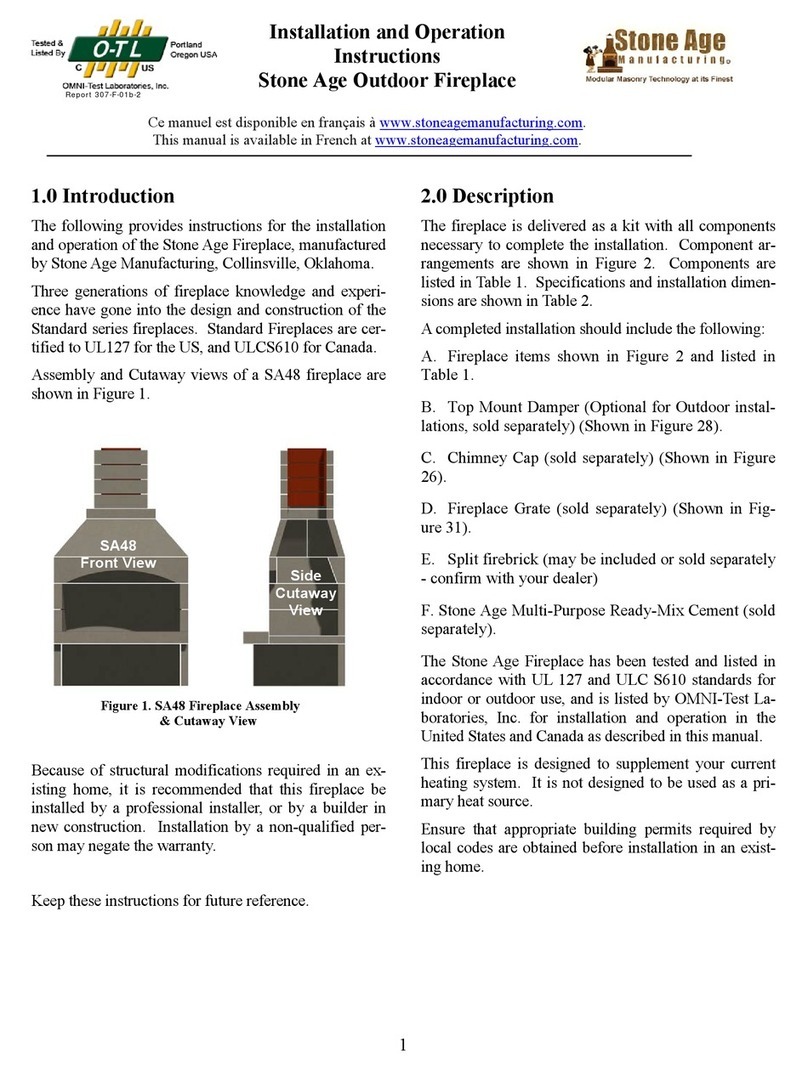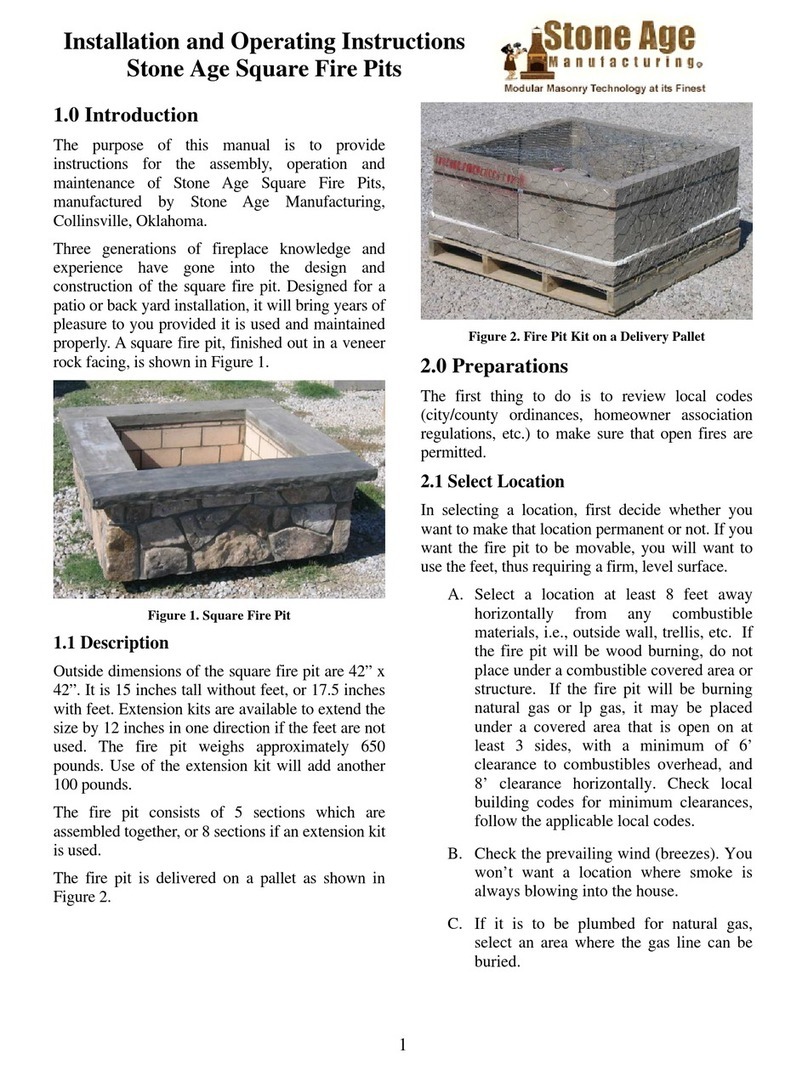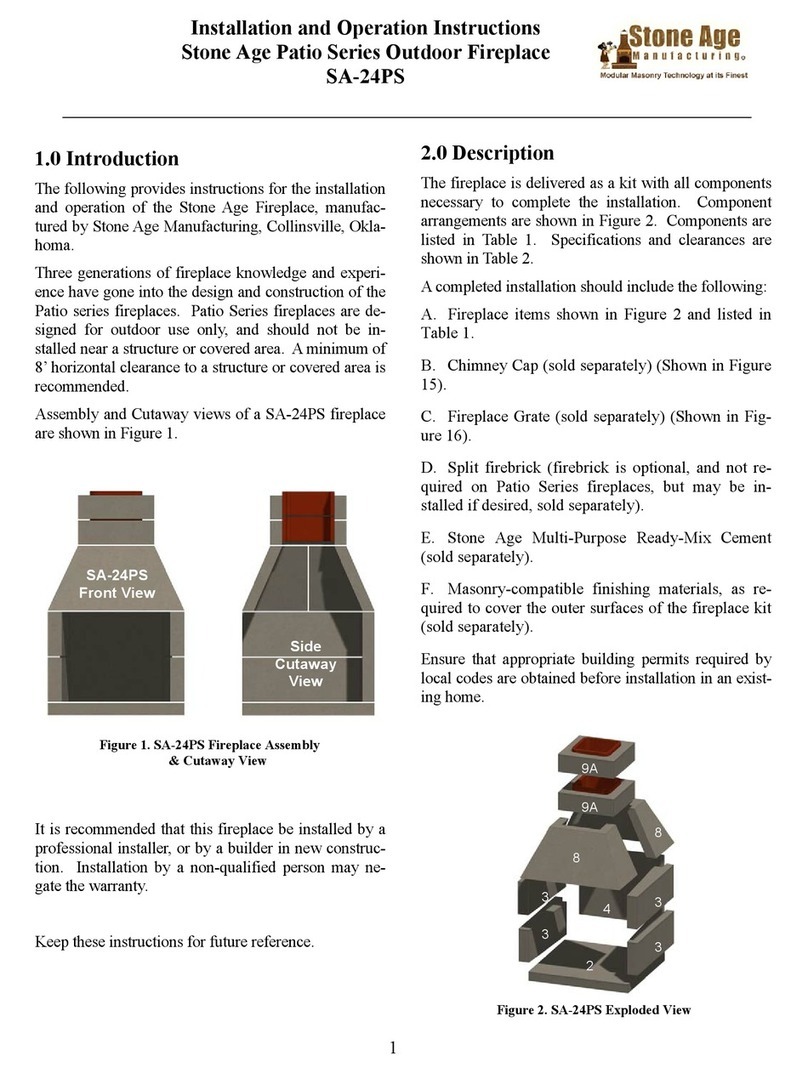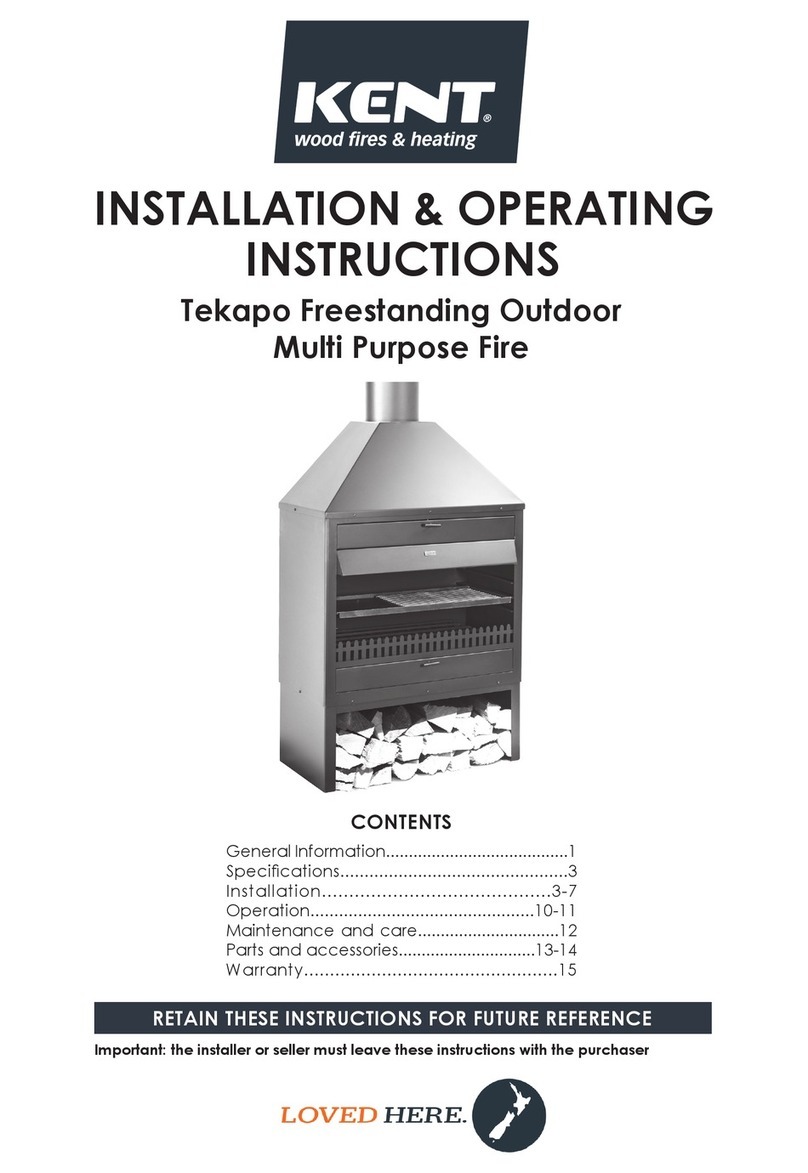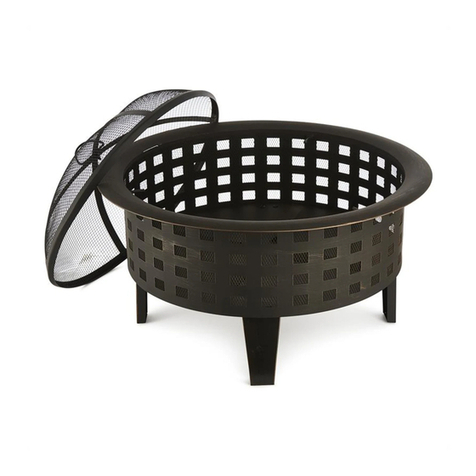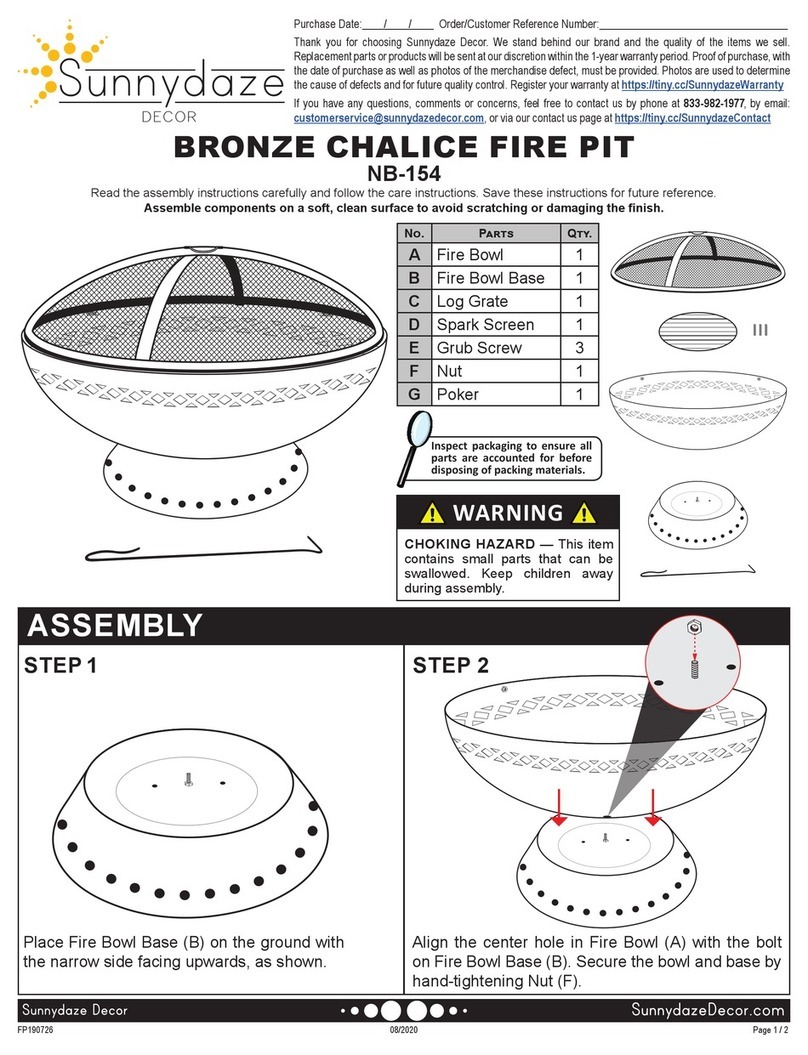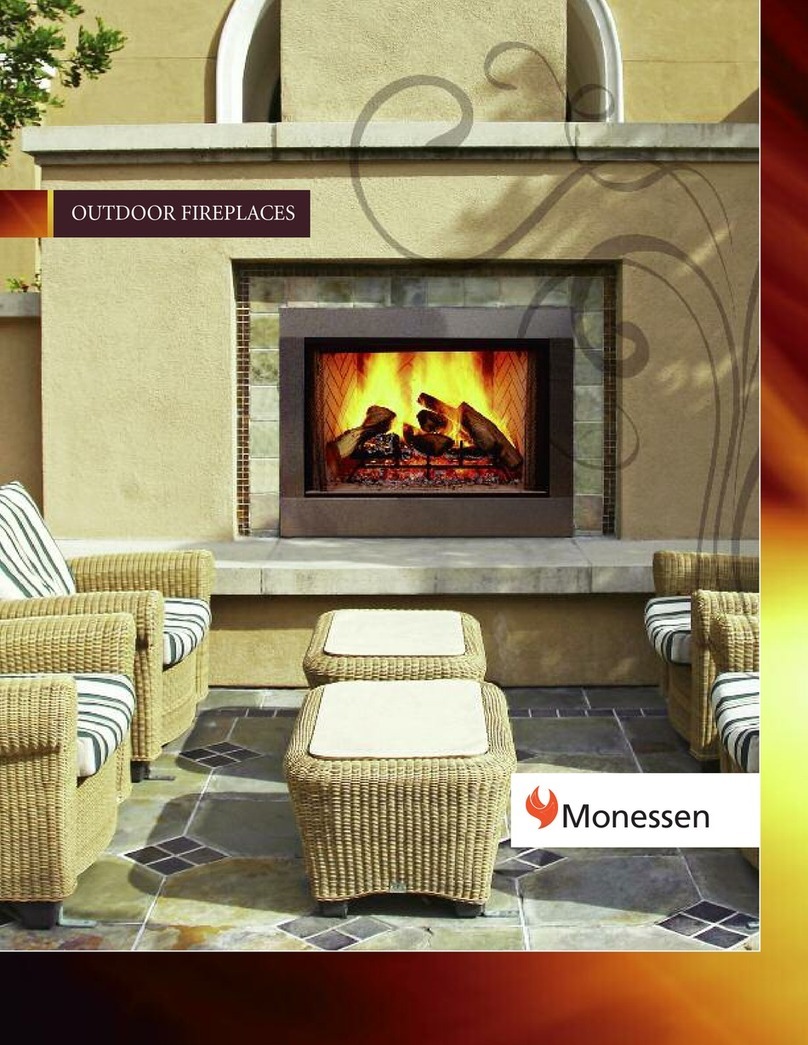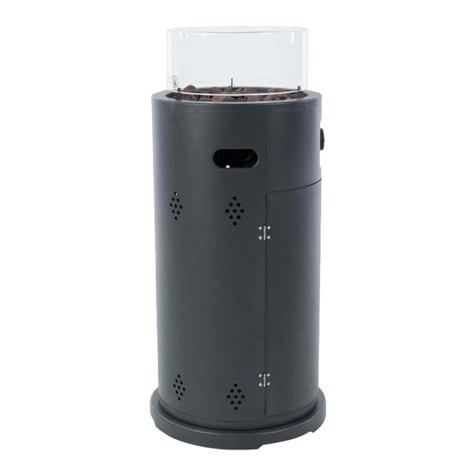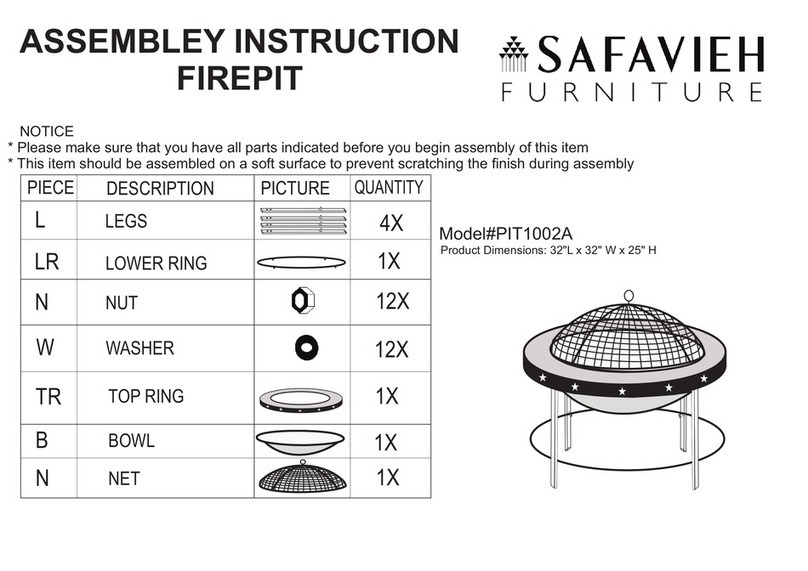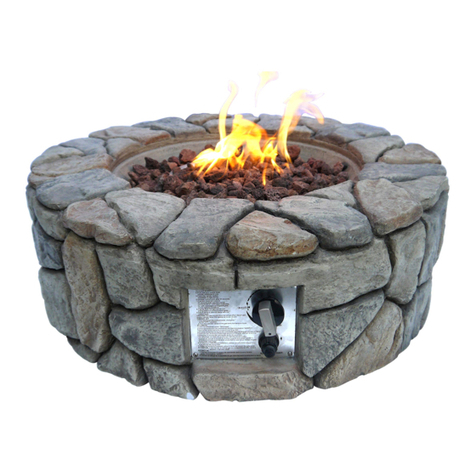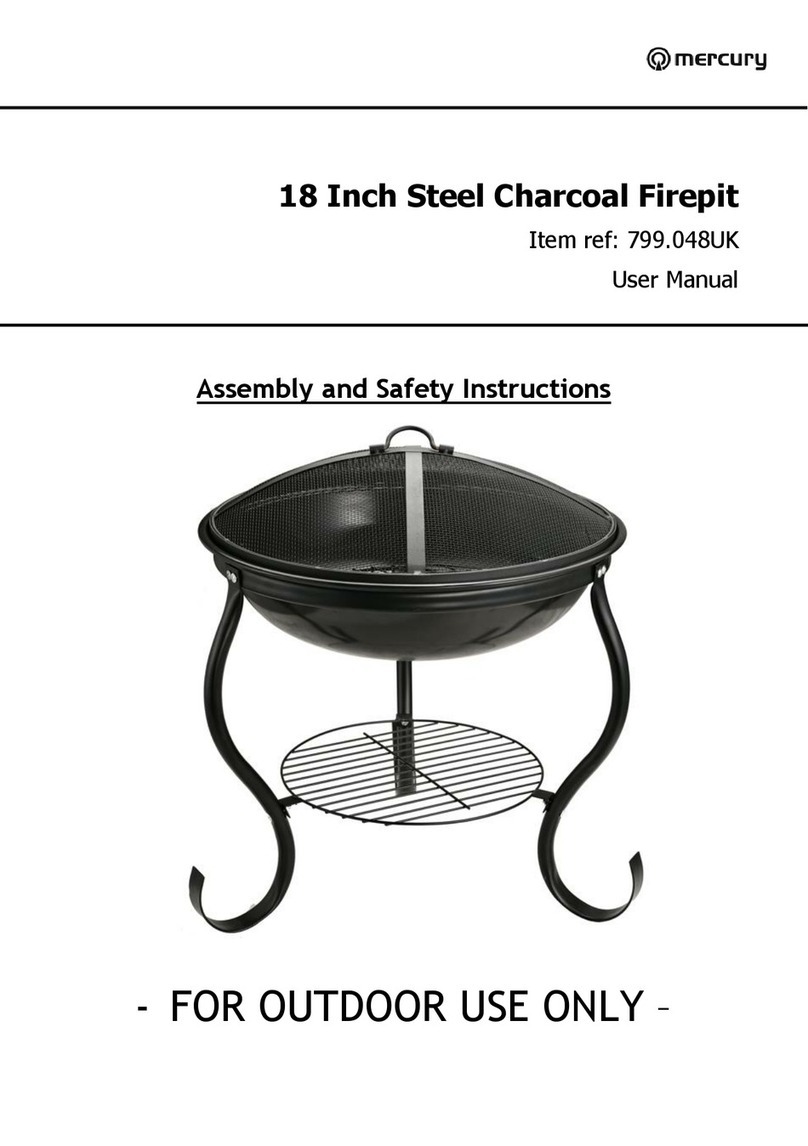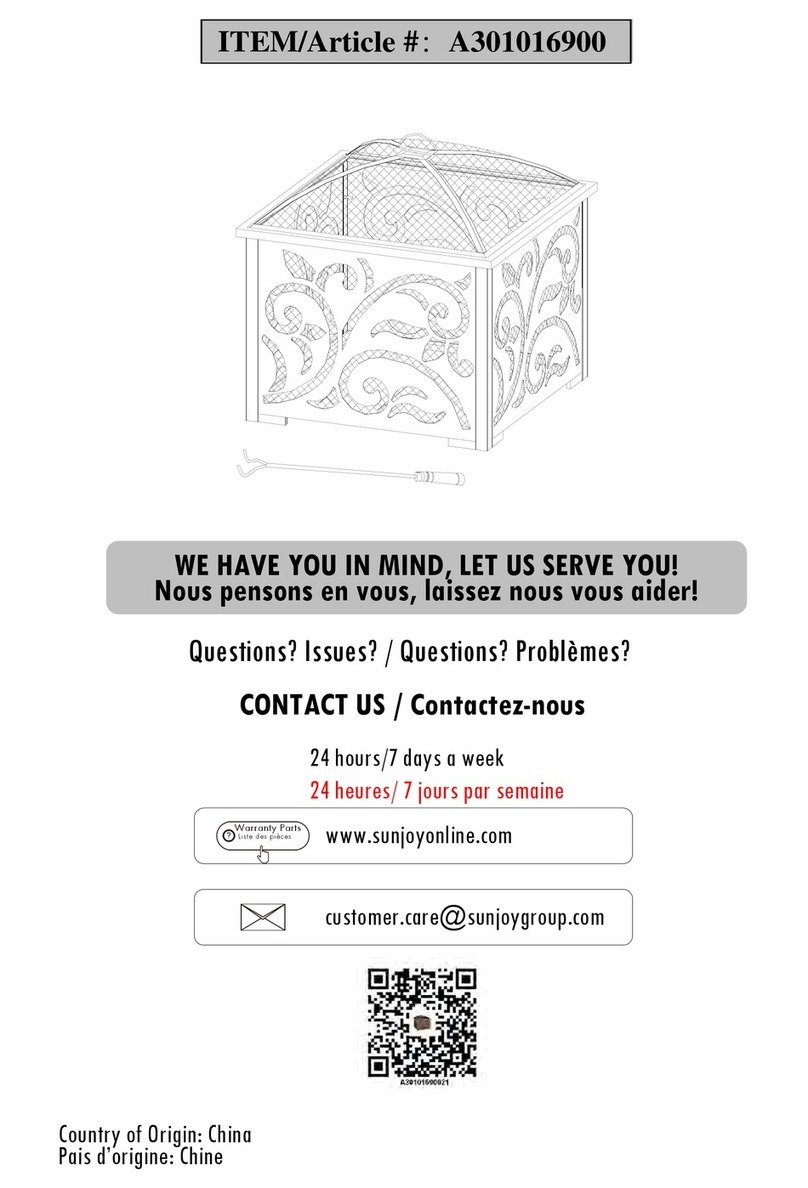StoneAge Patio Series User manual

1
Installation and Operation Instructions
Stone Age Patio Series Outdoor Fireplace
SA-48PS
1.0 Introduction
The following provides instructions for the installation
and operation of the Stone Age Fireplace, manufactured
by Stone Age Manufacturing, Collinsville, Oklahoma.
Three generations of fireplace knowledge and experi-
ence have gone into the design and construction of the
Patio series fireplaces. Patio Series fireplaces are de-
signed for outdoor use only, and should not be installed
near a structure or covered area. A minimum of 8’ hori-
zontal clearance to a structure or covered area is recom-
mended.
Assembly and Cutaway views of a SA-48PS fireplace
are shown in Figure 1.
It is recommended that this fireplace be installed by a
professional installer, or by a builder in new construc-
tion. Installation by a non-qualified person may negate
the warranty.
Keep these instructions for future reference.
2.0 Description
The fireplace is delivered as a kit with all components
necessary to complete the installation. Component ar-
rangements are shown in Figure 2. Components are
listed in Table 1. Specifications and clearances are
shown in Table 2.
A completed installation should include the following:
A. Fireplace items shown in Figure 2 and listed in
Table 1.
B. Chimney Cap (sold separately) (Shown in Figure
15).
C. Fireplace Grate (sold separately) (Shown in Figure
16).
D. Split firebrick (firebrick is optional, and not re-
quired on Patio Series fireplaces, but may be installed
if desired, sold separately).
E. Stone Age Multi-Purpose Ready-Mix Cement
(sold separately).
F. Masonry-compatible finishing materials, as re-
quired to cover the outer surfaces of the fireplace kit
(sold separately).
Ensure that appropriate building permits required by
local codes are obtained before installation in an existing
home.
SA-48PS
Front View
3
3
3
3
9A
8
8
9A
Side
Cutaway
View
Figure 1. SA-48PS Fireplace Assembly
& Cutawa
y
View
3
3
3
4
2
Figure 2. SA-48PS Exploded View
11

2
Table 1. Fireplace Components
Item Description Dimensions
2 Base Plate 33” x 58”
3 Sidewall 11” x 33”
4 Back Plate 22.5” x 40”
8 Throat 23” x 30” at top
9A Flue (Note 2) 23” x 23”
11 Throat Adapter 23” x 30”
Note 1: Item numbers refer to component numbers in Figure 2.
Note 2: Additional flue sections may be added to this fireplace,
up to a maximum of four feet. Additional flue sections must be
purchased separately.
Note: Drawings of the fireplace components,
with dimensions, are shown on page 10.
2.1 Specifications
Table 2: Clearances (See Figure 3)
Item Clearance Figure 3
Reference
Sidewall to Opening 18”
Top Trim to Opening 17” A
Side Trim to Opening 3”
Mantle to Opening 25” B
Floor to Opening 7”
Front Hearth Extension 24” C
Side Hearth Extension 12” D
Opening to Combustibles 48”
Clearance around Chimney
flue
2”
Note 1. This Fireplace is intended for use with solid wood fuel
or vented gas logs
Note 2: This fireplace has not been tested for use with glass
doors. To reduce the risk of fire or injury, do not install glass
doors.
Note 3: Do not use fireplace insert or other products not speci-
fied for use with this model. Use a fireplace grate when burning
wood.
Note 4: This fireplace has not been tested with an unvented gas
log. Do not install an unvented gas log set into this fireplace.
Note 5: Clay flue liners installed in flue section (item 9A, Figure
2) meet the specifications of ASTM Section C315-02.
Note 6: Make sure installation complies with local building
codes.
Note 7: Floor under unit must be non-combustible to earth
2.2 Installation of Additional Equipment
WARNING: THIS FIREPLACE HAS NOT BEEN
TESTED FOR USE WITH DOORS.
TO REDUCE THE RISK OF FIRE
OR INJURY, DO NOT INSTALL
GLASS DOORS.
A. Do not install a fireplace insert unless it is tested
with this fireplace.
B. Cutting or drilling a hole into the floor or walls for
gas supply for a vented decorative gas appliance (log),
fresh air venting, or an ash dump, is acceptable.
C. If a decorative gas appliance is installed, it must be
installed in accordance with the National Gas Fire
Code, ANSI Z223.1.
D. It must incorporate an automatic shutoff device.
E. Installation must comply with the Standard for Dec-
orative Gas Appliances in Vented Appliances, ANSI
Z21.60 (1991) or American Gas Association draft re-
quirements for Gas-Fired Log Lighters for Burning
Fireplaces, Draft No. 4 dated August 1993.
Figure 3. Patio Series Mantel & Hearth

3
3.0 Installation of the Fireplace
WARNING: DO NOT USE SUBSTITUTE
MATERIALS IN THE ASSEMBLY,
INSTALLATION OR OPERATION
OF THIS FIREPLACE. TO DO SO
WILL VOID THE WARRANTY
AND MAY RESULT IN FIRE AND
PERSONAL INJURY.
It is most important that the Stone Age fireplace be in-
stalled according to the following instructions. It is also
important that local building codes be consulted and
followed. Improper installation could result in:
• Overheating, leading to fireplace failure
• Leakage of rainwater through and around the
chimney
• Cracks and settling because of poor foundations
• Emission of smoke, sparks and gases into the
living area
• Combustion of materials adjacent to the fire-
place.
WARNING: THIS FIREPLACE HAS NOT BEEN
TESTED WITH AN UNVENTED
GAS LOG SET. TO REDUCE THE
RISK OF FIRE OR INJURY, DO
NOT INSTALL AN UNVENTED
GAS LOG SET INTO THIS
FIREPLACE.
Do not install this fireplace in a manufactured or mobile
home.
3.1 Preparations
Select a location in the home plans or outdoor living
area where all the minimum distances, as shown in Ta-
ble 2 and Figure 3 can be met. Proceed as follows.
Numbers in ( ) are item numbers from Table 1 and Fig-
ure 2. Ensure the base on which the fireplace is to be
installed is a solid and level foundation and is composed
of non-combustible material, such as concrete.
Due to varying climates, soil conditions, building codes,
construction methods and materials in different geo-
graphical regions, Stone Age recommends installers re-
view local building codes, consult with local building
officials and/or a structural engineer before beginning
the construction of any Stone Age product.
Pad or footings for outdoor installations should be a
monolithic pad constructed of steel reinforced concrete.
This fireplace may be placed on an existing reinforced
concrete patio, or a compacted gravel base if soils are
stable and no additional chimney is being installed with
the kit. Minimum footing specifications for fireplaces
built on stable soil, with overall height not exceeding 9
feet, are listed in Table 3. Locations with unstable soil
may require a deeper footing or the addition of piers, to
reach more stable subsoil or bedrock. Areas with colder
climates may also require deeper footings or piers that
reach below the frost line to prevent frost heaving. Piers
should include steel reinforcement that extends into the
footing above. See Figure 4.
If custom hearths or additional masonry structure is to
be attached to the fireplace kit, the footing dimensions
should be adjusted to include these customizations. If
customizing the unit, consult with an engineer to deter-
mine the structural requirements based on the overall
height, and the weight of fireplace, chimney, and finish
materials.
If local building code exceeds the manufacturer’s speci-
fications for footings, follow the local code.
Figure 4. Footing with Piers - Cutaway View
Piers

4
Table 3. Minimum Footing Specifications
Minimum Requirements for Footing SA-48PS
Thinner Finishes-
Fabricated Stone, Stucco, Stain or Tile
A
B
C
8” - 10”
39”
64”
Thicker Finishes-
Full Veneer Natural Stone or Brick
A
B
C
8” - 12”
45”
70”
See Figure 5.
Footing requirements for indoor installations should be
determined based on local building code. Consult with
a structural engineer to determine the footing require-
ments based on the overall height, and the weight of
fireplace, chimney, and finish materials. If custom
hearths or additional masonry structure is to be attached
to the fireplace kit, the footing dimensions should be
adjusted to include these customizations.
Use Stone Age’s Multi-Purpose Ready-Mix, or another
high temperature fire clay or refractory cement suitable
for indoor or outdoor use, and mix according to manu-
facturer’s instructions.
Once the fireplace is constructed you must wait at least
28 days before building a fire to give adequate time to
cure. This will provide ample time for any water residue
to evaporate, eliminating the adverse reaction of the
combination of water and fire.
Stone Age products are designed to be assembled using
a 3/8” fully bedded mortar joint for the kit pieces. Do
not “butter the edges” of the kit pieces.
Install the fireplace on a solid base, such as a cement
pad or concrete blocks. Two courses of 8” tall block will
set the floor height of the fireplace at approximately 19
inches from the floor.
WARNING: DO NOT USE RISER LEGS FOR
AN INDOOR INSTALLATION. IN
THIS INSTALLATION, THE VOID
BELOW THE FIREBOX COULD
INADVERTANTLY BE USED FOR
THE STORAGE OF
COMBUSTIBLE MATERIALS,
WHICH COULD CREATE A FIRE
HAZARD.
3.2 Assembly of Components
Components that become broken during shipment and
handling can be mortared back together providing the
breaks or cracks are clean and the original alignment can
be maintained. Components broken into multiple pieces
must be replaced.
If this is your first Stone Age installation, it is suggested
that you first assemble the components without mortar
to familiarize yourself with how the components fit to-
gether. See Figure 2.
During the actual assembly with mortar, ensure each
layer of the kit is plumb, level, and square before pro-
ceeding to the next step of the assembly.
A. Determine the height above the floor you want to
place the base plate (2). The base plate, without fire-
brick, will be 3” thick. If installing firebrick, the base
plate, plus firebrick, will be approximately 4 1/2 inch-
es thick. Mortar and set concrete blocks into place to
reach the desired fireplace floor height. Ensure the
block base is level and square. Additional blocks may
also be laid in front of the kit’s base plate to create a
base for a hearth. See Figures 6 and 7.
Concrete Block
Figure 6. Block Base
Figure 5. Footing with Piers
A
B
C Front

5
B. Set the base plate (2), ensuring it is level and
square. See Figure 8.
C. Install the lower sidewalls (3), ensuring they are
level and square. See Figure 9.
D. Install the upper sidewalls (3), ensuring they are
level and square. See Figure 10.
E. Install the back plate (4). Firebrick is optional on
this model. If choosing to install firebrick, install them
before placing the tapered throat pieces. See Figure
11.
F. Install the tapered front and rear throat pieces (8).
See Figure 12.
Figure 9. Lower Sidewalls
3
4
8
8
3
3
Figure 10. Upper Sidewalls
Figure 11. Back Plate
Figure 12. Throat Pieces
3
2
Base Plate
Figure 8. Kit Base Plate
Hearth Base
Figure 7. Block Base with Hearth

6
G. Install the throat adapter (11). See Figure 13.
H. Patio Series kits include 2 chimney sections. A
maximum of four additional feet of chimney is rec-
ommended with the Patio Series fireplaces. Install
the first Stone Age masonry chimney section (9A),
with the tile extending upward. Fill the void on the
bottom with mortar to create a smooth transition. See
Figure 14.
H. Install the next chimney section (9A), or any addi-
tional chimney sections to be installed. Fully bed each
piece in mortar, and filling in the gap between the clay
tiles in each section. Parge the joints to create a
smooth transition between each chimney section. Note
that if a tile is chipped or slightly out of square, it may
be used as long as it the joints are filled and smoothed
with high temperature mortar. See Figure 15.
This model is designed for outdoor use only, and
should not be placed near a structure or covered
area. A minimum of 8’ horizontal clearance to a
structure or covered area is recommended.
3.3 Exterior finishing
The exterior of the fireplace may be finished in any ma-
sonry-compatible material. Mantle and exterior veneers
may be fabricated stone, thin veneer or full bed depth
natural stone, tile, brick or stucco.
If the exterior finish will be stucco, stain, tile or manu-
factured thin stone, wrap the outside of the firebox with
metal lathe. Attach metal lathe to the firebox using con-
crete nails, tapcons, masonry or concrete anchors. Natu-
ral stone veneers (whether full bed depth or thin veneer),
full size brick, concrete pavers, CMU block, etc., do not
require metal lathe. Ensure the same refractory mortar
used to build the kit is used to install these materials.
9A
Figure 14. Chimney Flue
9A
Figure 15. Chimney Complete
11
Figure 13. Throat Adapter

7
3.4 Chimney Cap
At the top of the chimney, use mortar to create a cap,
sloping away from the clay flue and running out to the
edge of the finish material, to assist with water drain-
age. Install the chimney cap following instructions
provided. This will protect the chimney from rain,
birds, animals and leaves. See Figure 16.
4.0 Operating Instructions
4.1 Safety Precautions
A fireplace can bring many hours of enjoyment, comfort
and warmth if operated and maintained properly. Cer-
tain safety precautions must be observed to eliminate the
dangers associated with fire and provide a satisfactory,
smoke free fire.
A. When burning wood use solid, seasoned wood on-
ly. Do not use scrap wood or artificial wax based logs,
treated coal or woods dipped in pine tar or pitch.
B. Never use gasoline or other combustible liquids
when starting a fire.
C. Keep the chimney damper open while burning a
fire. Do not interrupt air flow. Ensure sufficient air is
present to support combustion. The manufacturer of
this fireplace is not responsible for interior smoke
resulting from lack of combustion air.
CAUTION: WHEN USING THE DECORATIVE GAS
APPLIANCE (VENTED GAS LOGS); THE
FIREPLACE DAMPER MUST BE SET IN
THE FULLY OPEN POSITION.
D. Keep a screen in front of the fireplace except when
tending the fire.
E. Keep combustible furniture/pillows at least four
feet from the opening.
F. Never leave the fire unattended.
G. Be extremely careful when adding wood and han-
dling fireplace tools. Never throw, kick or by any oth-
er means force wood into the firebox as this could
damage the firebrick and fireplace walls that could
result in permanent damage and void the warranty.
Stress cracks from thermal cycling are normal.
H. Do not alter this fireplace to the extent that it
would jeopardize the structural integrity of the fire-
place. Drilling or cutting a hole for a gas line, fresh air
vent or ash dump is acceptable. Use only Stone Age
authorized equipment with this fireplace.
4.2 Selection of Wood
Use cured wood logs only. Scrap wood produces
sparks. Treated wood, coal, or woods dipped in pine tar
should not be used because they may leave a combus-
tible residue in the fireplace and chimney.
Use of seasoned wood is preferred.
The amount of heat available from logs will depend on
the type of wood, its dryness, quantity of wood and the
size of the logs. Ten pounds of twigs will produce as
much heat as a 10 pound log, but will produce it much
faster because the air supply is more available.
4.3 Softwood vs. Hardwood
Wood is divided into two classes, hard and soft woods.
Each has a use in a fireplace and each has advantages
and disadvantages.
The hardwood category includes such woods as oak,
walnut, birch, elm and maple. Softwoods include pine,
fir, cedar and spruce.
Selection of wood depends on the type of fire you want.
Softwoods are good to offset a morning chill because
the fire develops faster. Hardwoods are preferable for a
slower burning and uniform heat output.
Softwoods contain a highly flammable resin that will
leave creosote soot in the chimney flue. This often re-
sults in sparking. Burning softwood exclusively will
require more frequent inspection and cleaning of the
chimney.
Experienced fire builders often use small amounts of
softwood kindling and newspaper when starting a split
hardwood log fire.
Figure 16. Mortar Cap and Chimney Cap

8
4.4 Seasoned Wood
Most freshly cut “green” wood will not burn well and
will smoke. The pressure of moisture and resin inside
green wood will build under heat and explode as sparks.
Therefore, it is recommended that only seasoned wood
be used in your fireplace.
Most wood requires 9 to 12 months of seasoning and
drying to reduce the moisture content enough to produce
good steady fires. Ensure that you buy only seasoned
wood, or if you buy green wood (usually cheaper), store
it properly to aid in the seasoning process. The follow-
ing steps will assist in the seasoning process.
A. Stack wood loosely to permit maximum air circu-
lation.
B. Do not stack wood on the ground. Use a wood
rack or stack on scrap lumber. Storage on the ground
will cause rotting and insect infiltration.
C. Cover wood stacks with a tarp so that it is not ex-
cessively exposed to the elements such as snow and
rain.
D. Do not stack wood against the walls of your home.
4.5 Building a Fire
A. Use a log grate (sold separately) with your fire-
place. This will contribute to good air circulation
around the wood, and keep the wood out of the ash.
This grate is shown in Figure 17.
B. Do not overload the wood grate with wood. Three
to four logs on the fire at one time are sufficient. Too
much wood on the fire at one time can result in “over
firing,” and too much heat in the firebox, causing dam-
age to the fireplace.
WARNING: NEVER USE GASOLINE,
GASOLINE-TYPE LANTERN
FUEL, KEROSENE, CHARCOAL
LIGHTER FLUID OR SIMILAR
LIQUIDS TO START OR
“FRESHEN UP” A FIRE IN THE
FIREPLACE. KEEP ALL SUCH
LIQUIDS WELL AWAY FROM
THE FIREPLACE WHILE IT IS IN
USE.
C. When lighting a fire in a cold chimney, a downdraft
may be created, letting a little smoke into the room.
To correct this, hold a wadded newspaper in the fire-
box and light it. This will create an updraft and clear
the flue of cold air.
D. Remove any excess ash from the fireplace. Exces-
sive ash may reduce airflow. Some owners prefer to
leave a small layer to insulate the cold refractory brick
below the grate, helping fire starting.
E. Center the grate over the bottom hearth of the fire-
box.
F. Crumble several newspapers across the fire area
below the grate. Criss-cross kindling wood on top of
the grate, above the newspaper.
G. Lay three logs on the grate; two side by side and
the third in pyramid fashion on top. Split logs will
start faster. Ensure there is space between the logs for
air circulation. As the air is heated, it is drawn up-
wards through the space between the logs, creating
more combustion.
H. Light the paper at both sides of the firebox.
Caution: The fireplace requires air for operation. En-
sure there is sufficient air so that other fuel
burning appliances are not starved of combus-
tion, ventilation, and dilution air.
I. Set the screen in front of the firebox to prevent the
escape of sparks and embers.
J. Ensure the fire remains centered in the firebox.
Don’t let it move to the front part. Move it back with
the poker.
K. Add wood to the fire as necessary.
CAUTION: Be extremely careful when adding wood to
the fire. Use proper fireplace tools and wear
gloves. Un-split logs will be less stable and
may be more likely to roll out of the fireplace
if not placed carefully on the log grate.
Figure 17. Log Grate

9
5.0 Cleaning, Inspection and
Maintenance
As is the case with most other equipment, cleanliness is
the best maintenance practice and will contribute too
many hours of warmth and pleasure.
WARNING: DO NOT CLEAN THE FIRE-
PLACE WHEN IT IS HOT.
A. Creosote – Formation and Removal. When wood is
burned slowly, it produces tar and other organic va-
pors, which combine with expelled moisture to form
creosote. The creosote vapors condense in the rela-
tively cool chimney flue of a slow burning fire. As a
result, creosote residue accumulates on the flue lining.
When ignited, this creosote makes an extremely hot
fire. The chimney shall be inspected at least twice a
year during the heating season to determine when a
creosote buildup has occurred. If a significant layer of
creosote has accumulated (3 mm or more), it should be
removed to reduce the risk of a chimney fire.
B. Disposal of ashes - Ashes should be placed in a
metal container with a tight-fitting lid, and taken out-
side and placed on the ground, well away from all
combustible materials, pending final disposal. If the
ashes are disposed of by burial in soil or otherwise lo-
cally dispersed, they should be retained in the closed
container until all cinders have thoroughly cooled.
C. The grate may be removed from the firebox for
cleaning. However, ensure it is returned prior to lay-
ing the next fire.
D. Keep the fireplace screen clean so air flows freely
through it.
E. Spot check the firebricks (if installed) and mortar
for small cracks. It will expand slightly with the heat,
and then contract as it cools. Replace firebricks when
the cracks open more than ¼”; or when pits become
extensive and deeper than 3/16”; or when any piece of
refractory larger than 2 inches in diameter becomes
dislodged.
F. If creosote has accumulated, it should be removed
to reduce the risk of a chimney fire. Clean the chim-
ney as outlined below or have the chimney cleaned by
a professional chimney sweep.
WARNING: DO NOT USE CHEMICAL
CHIMNEY CLEANERS THAT ARE
POURED ON A HOT FIRE. THE
CHEMICAL CLEANER CAN BE
DANGEROUS AND GENERALLY
WILL ONLY WORK ON THE
FLUE SECTION NEAREST THE
FIRE, LEAVING THE REST OF
THE FLUE UNAFFECTED.
G. Inspect the top cap and opening in your chimney
top and remove any debris that could clog it. If possi-
ble, birds will often nest there, and it must be kept
clear of nest material.
H. Cover the firebox opening with a damp sheet and
seal with masking tape to retain soot in the firebox
while cleaning.
I. Inspect the entire flue from the top down for ob-
structions. Use a flexible handled cleaning brush. If
the chimney contains offset/return elbows, clean from
the top down to the offset, then from the firebox up to
the offset.
J. After completion of cleaning, use a vacuum clean-
er to remove all soot and residue from the firebox.
6.0 Finishing Specifications
Approximate finishing specifications, firebrick count,
and mortar coverage are estimated in Table 4 below.
Coverage amounts may vary due to weather conditions,
type of finish material, size of mortar joints, and skill
and efficiency of the mason or installer.
Table 4 does not account for waste. Add the appropriate
waste factor for your material type and skill level.

10
Table 4. Finishing Requirements
Kit Components
Surface Area
Corner Length
94 square feet
22 Linear feet
Ready-Mix Mortar Required
for Kit Assembly 5 Buckets/Bags
Mortar Required for Kit Fin-
ishing 3 - 6 Buckets/Bags
Firebrick Required 105 Split Brick
(not required)
Additional Chimney
(Per Chimney Section)
Surface Area:
Corner Length:
4 square feet
2 Linear feet
Ready-Mix Mortar Required
for Assembly 1/8 Bucket/Bag
Mortar Required for
Finishing
1/8 - 1/4
Buckets/Bags
Fireplace Components
SA-48PS
2
Base Plate
3
Lower/Upper
Side Wall
4
Back Plate
8
Throat
9A
Flue
58”
33”
33”
11”
40”
22.5”
30”
58”
23”
23”
This Space Intentionally Left Blank
30”
23”
11
Throat
Adapter

11

12
Stone Age Fireplace Instructions
Model SA-48PS
Revised 02/2020
Printed in USA © 2013-2020, All Rights Reserved
Stone Age Manufacturing, Inc
LIMITED WARRANTY
The products of Stone Age Manufacturing, Inc. (“Stone Age”) have
been carefully manufactured and the components assembled to give the
customer a quality product. Stone Age warrants to the original pur-
chaser the materials that it provides to the customer against defects in
manufacture for a period of twenty-five (25) years from the date of pur-
chase on UL-127 listed fireplaces, for a period of five (5) years from the
date of purchase on all unlisted fireplaces, fire pits, and other masonry
components. Other accessory items or components offered, but not
produced by Stone Age Manufacturing, Inc., shall be covered by their
manufacturer’s warranties. This Limited Warranty covers only actual
manufacturing defects in the Stone Age product and does not cover de-
fects or faulty workmanship in the installation of the product or the ma-
sonry or other structure in which it is installed. Also this warranty does
not cover items that have been damaged due to over-heating, modifica-
tion, improper storage or maintenance. Stone Age shall repair or re-
place, at its option, any defective Stone Age product component upon
receipt of written notice addressed to Stone Age. This Limited Warran-
ty covers only replacement of any defective components within the
product itself occurring during the warranty period and does not cover
the cost of installation or removal from a fixed location. NO OTHER
WARRANTIES, EXPRESS OR IMPLIED, ARE MADE, INCLUDING
IMPLIED WARRANTIES OF MERCHANTABILITY AND FITNESS
FOR PARTICULAR PURPOSES WHICH ARE SPECIFICALLY
DISCLAIMED. Stone Age is not liable for damages or injury to per-
sons or property or other incidental or consequential damages.
Stone Age Manufacturing, Inc.
11107 E. 126th St. N., Collinsville, OK 74021
https://stoneagemanufacturing.com
Other manuals for Patio Series
1
This manual suits for next models
1
Table of contents
Other StoneAge Outdoor Fireplace manuals
Popular Outdoor Fireplace manuals by other brands

for Living
for Living Amelia 085-0030-6 Assembly instructions
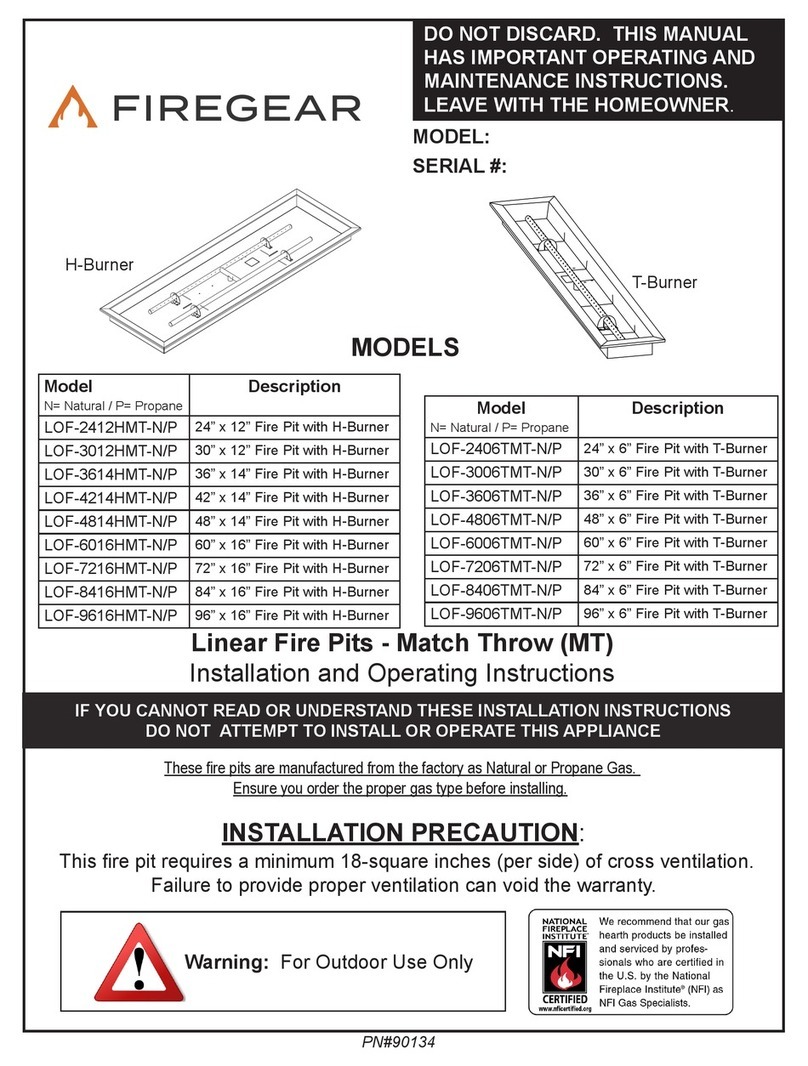
Firegear
Firegear LOF-4214HMT-N Installation and operating instructions
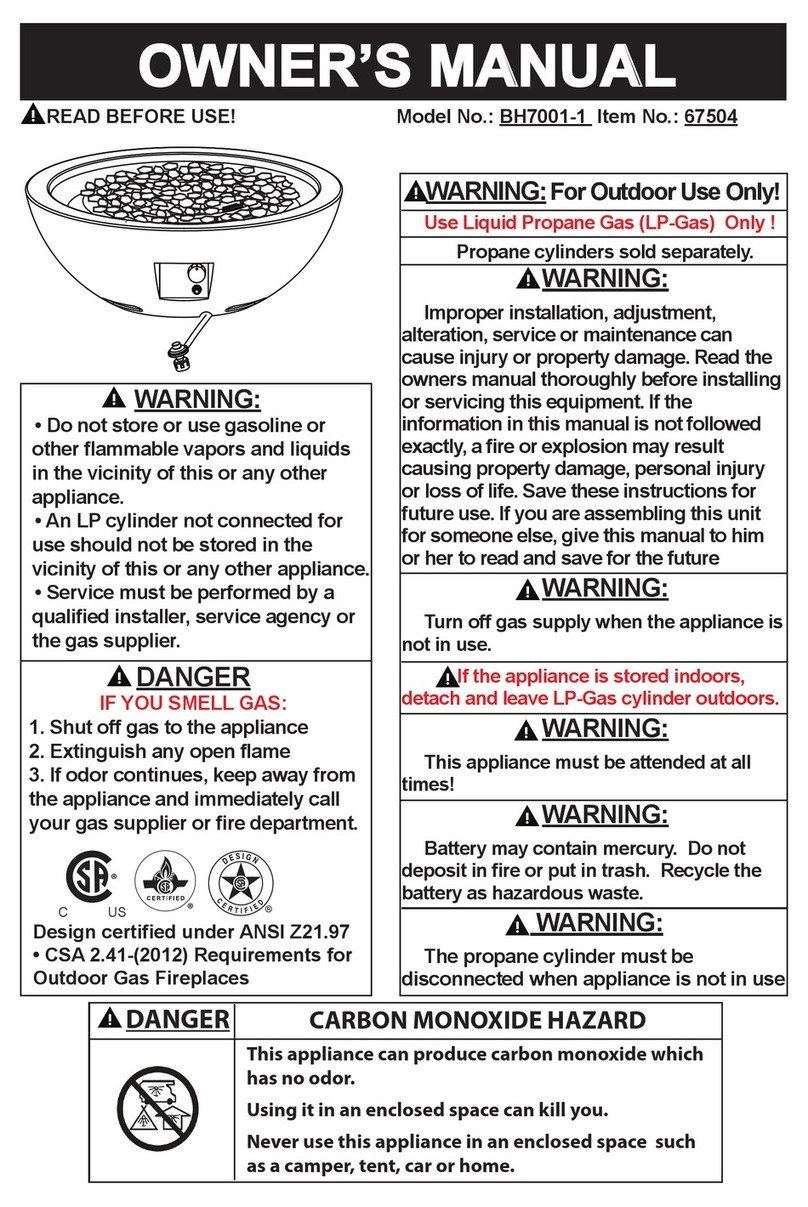
Sapho
Sapho BH7001-1 owner's manual
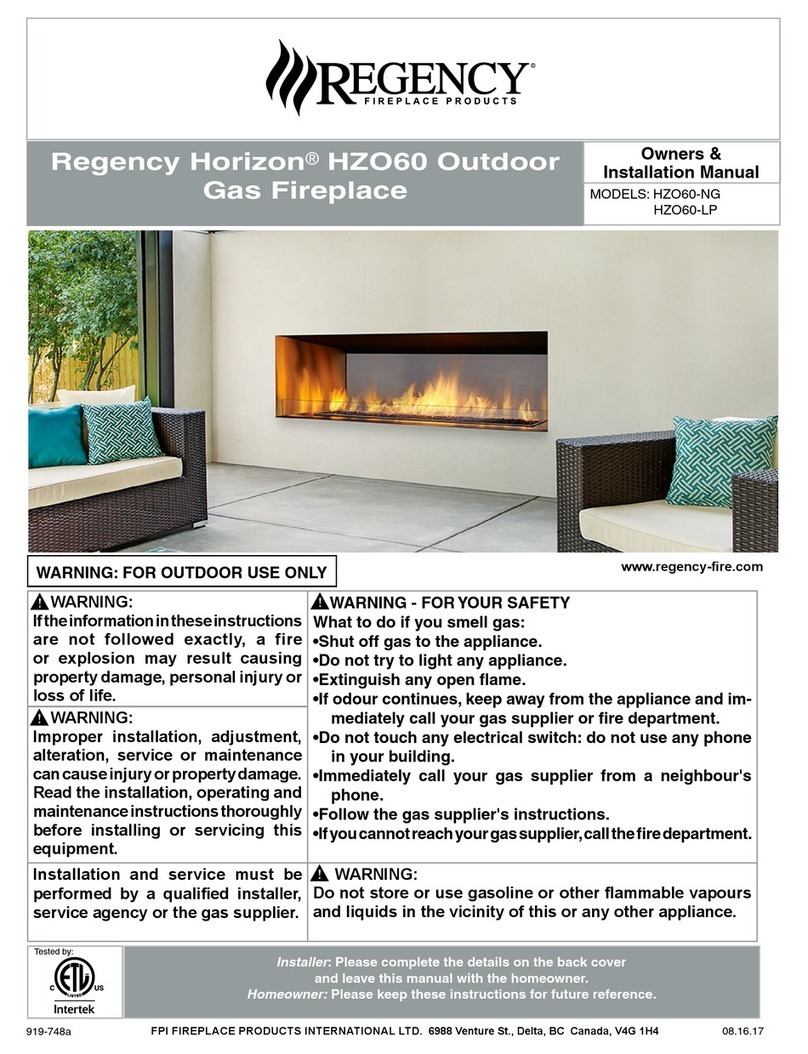
Regency
Regency Horizon HZO60-NG Owners & installation manual

tepro
tepro SILVER CITY user manual
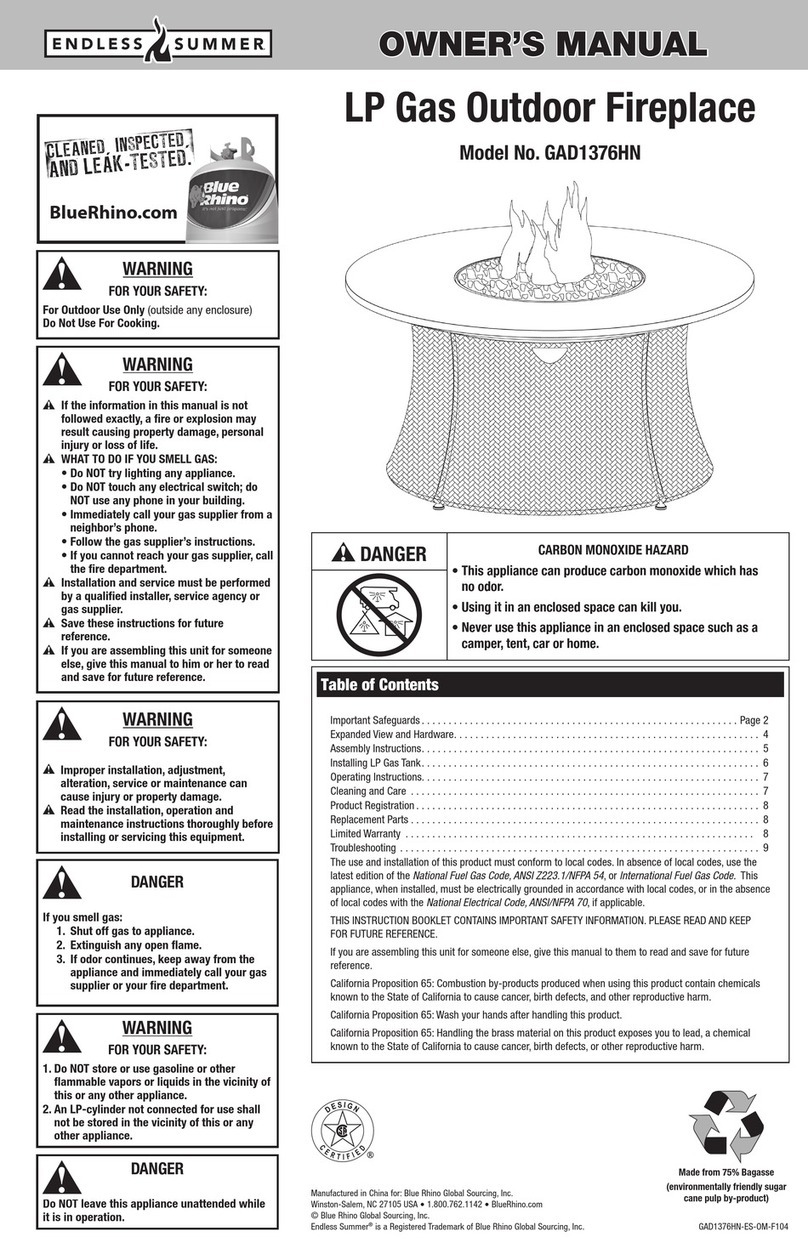
Endless Summer
Endless Summer GAD1376HN owner's manual
